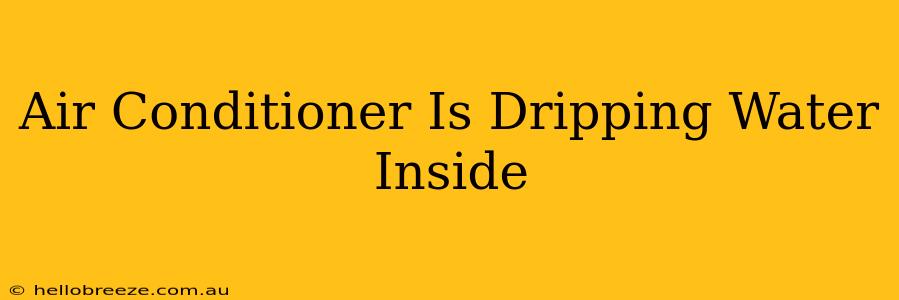Is your air conditioner dripping water inside? This annoying problem can be more than just a nuisance; it can signal a more serious issue that needs immediate attention. Don't panic! This comprehensive guide will walk you through the common causes of indoor AC dripping and provide effective solutions to get your system back to its cool, dry best.
Understanding Why Your AC is Dripping Water Inside
Before we dive into solutions, let's understand why your air conditioner might be dripping water inside. The most frequent culprits are related to condensation and drainage problems. Air conditioners work by removing moisture from the air. This moisture condenses and collects in a condensate pan, typically located within the unit itself. If the drainage system malfunctions, the water overflows, leading to those unwelcome drips.
Common Causes of Indoor AC Dripping:
- Clogged Drain Line: This is the most common reason. Dust, debris, algae, and even mold can clog the drain line, preventing water from draining properly.
- Frozen Evaporator Coil: A frozen evaporator coil restricts airflow and prevents proper condensation drainage. This often stems from restricted airflow, dirty air filters, or refrigerant problems.
- Condensate Pan Issues: Cracks or holes in the condensate pan itself will obviously lead to leaks.
- Low Refrigerant: Insufficient refrigerant can cause the evaporator coil to freeze, ultimately leading to water dripping.
- Dirty Air Filter: A clogged air filter restricts airflow, leading to a frozen evaporator coil and subsequent dripping.
- Incorrect Installation: In some cases, improper installation can lead to drainage problems.
Troubleshooting Your Dripping Air Conditioner
Let's tackle how to troubleshoot and fix these common issues:
1. Check the Condensate Drain Line
This is your first step. Locate the drain line (usually a PVC pipe) connected to the condensate pan. Carefully examine it for any clogs. You might need a shop vacuum or a wet/dry vac to clear out the blockage. A small plumbing snake can also be very effective.
2. Inspect the Condensate Pan
Carefully examine the condensate pan for any cracks or holes. If damaged, replacement is usually necessary.
3. Check the Air Filter
Replacing a dirty air filter is crucial. A clean filter ensures proper airflow and prevents the evaporator coil from freezing. Consult your AC unit's manual for the correct filter type and replacement frequency.
4. Examine the Evaporator Coil (Advanced)
This step requires some technical knowledge and should ideally be done by a professional. If you suspect a frozen evaporator coil, you need to identify the cause (low refrigerant, restricted airflow, etc.) and address it. Attempting to fix this yourself without proper training can be dangerous and void your warranty.
5. Consider Professional Help
If you've checked these points and your AC is still dripping, it's time to call in a qualified HVAC technician. They possess the expertise and tools to diagnose more complex problems, such as refrigerant leaks or electrical issues. Ignoring persistent problems could lead to further damage and increased repair costs.
Preventing Future Drips
Regular maintenance is key to preventing future problems.
- Change your air filter regularly. This is the single most important preventative measure.
- Schedule annual professional maintenance. A yearly inspection by a qualified technician can identify potential issues before they become major problems.
- Keep the area around your air conditioner clean and clear. This ensures proper airflow and prevents debris from clogging the drain line.
By following these troubleshooting steps and preventative measures, you can keep your air conditioner running smoothly and prevent annoying water drips from spoiling your comfort. Remember, tackling the problem early can save you time, money, and a lot of frustration!

